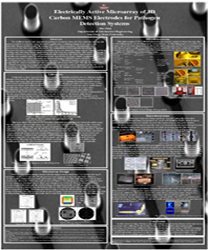 |
||||||||
 |
 |
 |
 |
 |
| Electrically Active Microarray of 3D Carbon MEMS Electrodes for Pathogen Detection Systems | ||
|
The ability to isolate and concentrate pathogens
(bacteria, virus, etc), biomolecules and any sub-micron particle
is critical to many biomedical applications, including diagnosis
for cancer and infectious disease (SARS, deadly flu strains, STD,
etc). Conventional two-dimensional active microarrays have been
used with success for the manipulation of biomolecules including
DNA. However they have a major drawback of inability to process
relatively â?~large-volumeâ?T samples useful in oncology
and infectious disease applications. This research presents an active
microarray that exploits electrokinetic (electrophoresis and dielectrophoresis)
forces for its hybridization method using 3D carbon electrodes that
will enable the large volume manipulation for pathogen detection.
Carbon electrodes are fabricated using C-MEMS (Carbon MEMS) technology
is an emerging fabrication method that enables low cost fabrication
of MEMS devices exploiting fascinating physical,
| ||
|
chemical, mechanical and electrical properties
of carbon materials. The chip fabricated using C-MEMS technology
is packaged and the efficiency of separation and accumulation of
the 3D electrodes on the chip is tested by manipulating negatively
charged polycarboxylate 2 micron beads in 50 mM histidine buffer.
|
||
| • Other Abstracts • | ||
